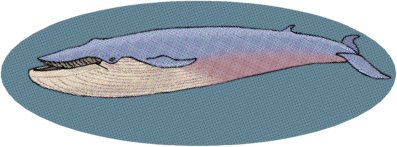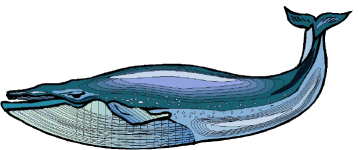Blue Whale
| Order | Cetacea |
| Family | Balaenopteridae |
|
Genus & Species | Balaenoptera cetacea |
|
Length | Males average 82 feet; Females, 85 feet |
| Weight | 175000-285000 pounds |
| Sexual maturity | Males at a lenght of 74 feet Females at 75 feet |
| Mating | Most females breed only once every 3 years |
| Gestation | 11-12 months |
| Number of Young | Single calf |
| Call | Low-frequency moan. Produces ultrasonic chirps and whistles when feeding |
| Habit | Social and migratory |
| Diet | Plankton |
| Lifespan | 80 years |
Like other marine mammals, blue whales are descended from early land animals. Millions of years ago,
the richness of life in the sea lured them to water, and aquatic life gradually changed their physical
characteristics. Today, they spend most of their time in the Arctic and Antarctic Oceans, where plankton
is plentiful. In winter, the whales migrate to the warm waters of the tropics. But food in the tropics is
scarce, so the whales depend on their thick layer of blubber for nourishment.

Blue whales form close ties with one another and are often seen in groups of two or four. Mating takes
place in the warm waters of the tropics, where the young are born. The mother gives birth to a single calf
with the aid of other females, who help her deliver the calf and then nudge the newborn to the surface
for its first breath of air. At birth,
the calf measures about 23 feet and weighs 16000 pounds. The baby
suckled in the water, drinking more than 160 gallons of milk a day.
At 7 months, it is able to catch its own food.
In the
Antarctic, blue whales feed on vast quantities of a plankton called
krill. In Arctic waters, they
feed on only three species of
crustacean (shelled) plankton. Icy water contains more oxygen and
carbon dioxide
than warm water, which makes it rich in marine
life. Plankton is up to twenty times more abundant in the Arctic
and Antarctic than it is in the warm waters of the tropics. In
spite of its bulk, the blue whale can reach speeds
of 10-15 knots.
But it catches most of its food by diving. It can dive to depths of
1650 feet and lie
submerged for up to 2 hours. Rising from the
depths, the whale feeds by collecting a large amount of seawater in
its mouth and then straining out the plankton.

Because of its great size, the blue whale was a prime target for the whaling industry. Its body was a source of
oil and the baleen was used to make women's corsets. Antarctic
whalers slaughtered 30000 blue whales from 1930 to 1931.
The
population has since recovered, but there are probably less than
10000 alive today; they are now protected.
| DID YOU KNOW? |
The biggest blue whale ever recorded was 102 feet long.
The heaviest one recorded weighed
390,000 pounds |
Blue whales were once called sulphur-bottom whales by sailors
because their bodies became
covered with algae
which was greenish-yellow like sulphur
|
Information is Copyright IMP BV/IMP Inc.
Wildlife Fact File
| Great
White Shark | Sea Otter |
| Sea Horse | Blue Whale
|
| Octopus | Bottlenose
Dolphin |
| Sperm Whale | California
Sea Lion |
| Elephant Seal | Adopt An
Animal |
| Home |
| Michele |
Links |
Sign Language |
| Adoptions |
Animals
| Say No To Drugs |
| Holidays | History |
|
All graphics and
pages are copyright © 1997 - 2008 Pages 4 Ever
(except where noted). Do not take, copy, steal, plagiarize or use in any
way, shape or format without the express written permission of Pages
4 Ever.
Some backgrounds and graphics made from clipart acquired from ArtToday, Boxed Art,
friends, my own imagination, and/or
graphic CD collections that I have purchased. If you find anything on this site
that you have copyright to, and can prove it, please let me know and I will
gladly either remove it or place a link back to you, whichever you prefer.
If you should find any broken links, please drop us a line and let us know the
exact URL the broken link is on. Thank you.
|
|